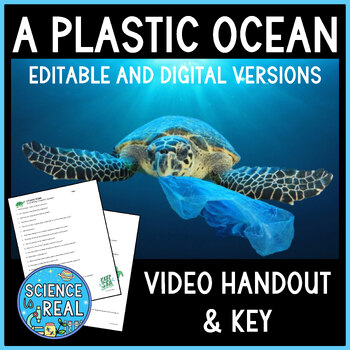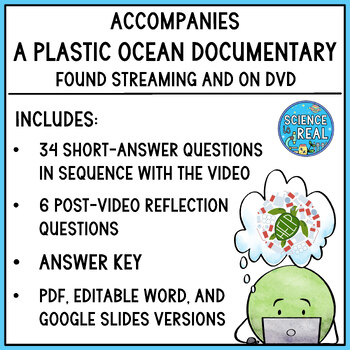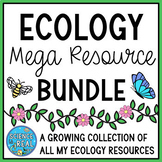A Plastic Ocean Worksheet Movie Questions and Answer Key
- Zip
- Google Apps™

What educators are saying
Also included in
- ⭐ ⭐ ⭐ ⭐ ⭐ Save Over 30% with this growing collection of all things earth science and astronomy! This is a growing collection of secondary earth science, space science, and astronomy resources. If you purchase this growing bundle today, you will receive all future added resources for free, for life!Price $456.99Original Price $653.00Save $196.01
- ⭐ ⭐ ⭐ ⭐ Save money and time with this Ecology Growing Bundle! Get this growing bundle now before more products are added and the price increases! These resources are designed for standard high school or advanced middle school science students. More resources will be soon added as I create new produPrice $234.99Original Price $336.48Save $101.49
Description
⭐⭐⭐ ⭐ A Plastic Ocean is an engaging, effective, and informative documentary about the causes, effects, and human impacts of plastics in our oceans. This download includes an editable video handout, PDF, and digital Google Slides version of the handout, and an answer key. You can find the full documentary on streaming sites or on DVD.
The handout includes 34 short answer questions that are timed in sequence to the video, and 6 summarizing and analysis questions. The first 34 questions are formatted short-answer style, however no answer is much longer than 1-3 words. The questions are spaced out so that they do not go too fast or too slow and encompass the entire film from start to finish. The digital Google Slides version has pre-formatted text boxes and appropriate spacing for digital use.
This assignment is perfect for an introduction or enrichment to human impact, the environment, and ocean ecosystems, and a great sub-plan for Biology, Ecology, and Environmental Science classes.
⭐ TOPICS INCLUDE ⭐
✔ Plastic Pollution
✔ Impacts of Plastics in Food Chains
✔ Biomagnification
✔ Bioaccumulation
✔ Human Impact
✔ The Great Pacific Garbage Patch
✔ Effects of Plastics on Human Health
✔ BPA
⭐ WHAT YOU WILL RECEIVE ⭐
- Editable Student Handout in MS Word (2 Pages)
- PDF of Student Handout (2 Pages)
- Google Slides Version of Student Handout
- Answer Key
⭐ You may also like ...
• Human Impact On The Environment Webquest
• Climate Change CER, Reading Comprehension, and Graphing Lab
• Modeling Biomagnification and Bioaccumulation of Mercury Lab Activity
• Biodiversity, Water Pollution, and Biomagnification Webquest
Description from IMDb -
“A PLASTIC OCEAN begins when journalist Craig Leeson, searching for the elusive blue whale, discovers plastic waste in what should be pristine ocean. In this adventure documentary, Craig teams up with free diver Tanya Streeter and an international team of scientists and researchers, and they travel to twenty locations around the world over the next four years to explore the fragile state of our oceans, uncover alarming truths about plastic pollution, and reveal working solutions that can be put into immediate effect.”
⭐ As of 3/25/24, you can watch it free on YouTube here! This may change, so please make sure you can access the documentary on YouTube and other streaming services such as Amazon here. You can also purchase the DVD here.
Happy Sciencing!
⭐ Connect with Me!
❤️ CHECK OUT MORE GREAT THINGS FROM SCIENCE IS REAL! ❤️
⭐ HUMAN IMPACT AND THE ENVIRONMENT ⭐
• Human Impact On The Environment Webquest
• Climate Change CER, Reading Comprehension, and Graphing Lab
• Climate Change Stations Lab - Student-Led Climate Change Stations
• Biodiversity Reading Comprehension Worksheets
• Biodiversity and Endangered Species Webquest
• Biodiversity, Water Pollution, and Biomagnification Webquest
• Modeling Biomagnification and Bioaccumulation of Mercury Lab Activity
• Cookie Mining Lab - Natural Resources CER Edible Lab Activity
• Natural Selection in Peppered Moths Reading, Color, and Camouflage Activity
• Peppered Moth Natural Selection Webquest
⭐ ECOLOGY ⭐
• Ecology Bundle - Growing Ecology Resource Bundle
• Aquatic Ecosystems PowerPoint with Notes, Questions, and Kahoot
• Food Chains, Food Webs, and Energy Pyramids Reading Comprehension Worksheets
• Biodiversity Reading Comprehension Worksheets
• Biodiversity and Endangered Species Webquest
• Biodiversity, Water Pollution, and Biomagnification Webquest
• Cookie Mining Lab - Natural Resources CER Edible Lab Activity
• Modeling Biomagnification and Bioaccumulation of Mercury Lab Activity
• Carbon Cycle Game - Rotation Stations Game with Analysis and Assessment
• Ocean Zones Poster Project - Layers of the Ocean
• Biogeochemical Cycles Diagrams Worksheets Bundle
Science Is Real! Terms of Use (TOU):
By purchasing this product, you own a license for one teacher only for personal use in their own classroom. Licenses are non-transferable and therefore cannot be passed from one teacher to another. If the teacher who purchased this license leaves the classroom or changes schools, the license and materials leave with that teacher. No part of this resource is to be shared with colleagues or used by an entire team, grade level, school or district without purchasing the correct number of licenses. If you are a coach, principal or district interested in transferable licenses that would accommodate yearly staff changes, please contact me for a transferable license quote at ajcatts@gmail.com or scienceisrealeducation.com
Please note - all material included in this resource belongs to Ana Catts. By purchasing, you have a license to use the material, but you do not own the material. You may not upload any portion of this resource to the internet in any format, including school/personal websites or network drives unless the site is password protected and can only be accessed by students, not other teachers or anyone else on the internet.
Purchase of the product is for single classroom use by the purchaser only. It is a violation for individuals, schools, and districts to redistribute, edit, sell, or post this item on the public Internet or to other individuals. Disregarding the copyright is a violation of the Digital Millennium Copyright Act and subject to legal action.
-By purchasing this product you acknowledge that you have read and understood the Terms of Use.
Dude Dots Clipart by the talented (C)Sarah Pecorino Illustrations
HAPPY SCIENCING!
⭐ Connect with Me!
❤️ CLICK TO FOLLOW SCIENCE IS REAL!
Get News of Sales, New Products, and Discounts!







